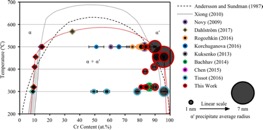Current and past team members
Main collaborators: Bob Odette (UCSB) and Dane Morgan (U. of Wisconsin), Arthur Motta (Penn State), Djamel Kaoumi (NC State), and Khalid Hatter (SNL), Julie Tucker (Wash U), Grace Burke (Manchester).
Our contribution
Ion irradiation of Fe-Cr alloys
Ferritic-martensitic steels are a leading candidate for many nuclear energy applications. However, formation of nanoscale α’ precipitates during thermal aging at temperatures above 450 °C, or during neutron irradiation at lower temperatures, makes these Fe-Cr steels susceptible to embrittlement. To complement the existing literature, a series of Fe-9 to 18 Cr alloys were neutron-irradiated at temperatures between 320 and 455 °C up to fluences of 20 dpa and an Fe-18Cr alloy was ion or neutron-irradiated at 300-320 ºC at dose rates from ~10-7 to 10-4 dpa/s. In addition, post-irradiation annealing treatments at 500 and 600 °C were performed on a neutron-irradiated Fe-18 Cr alloy to validate the α-α’ phase boundary. The microstructures were characterized using atom probe tomography (APT) and the results were analyzed considering APT technique artefacts, measurement procedures, irradiation conditions, and cascade ballistic mixing. The major findings are:
- The α’ precipitation behavior under neutron irradiation is generally consistent with near equilibrium thermodynamic with radiation-accelerated diffusion, including increasing α’ number density with increasing Cr content and decreasing temperature, as well as heterogeneous nucleation on dislocations for lower Cr compositions and higher temperature [1].
- The α’ precipitate composition measured by atom probe tomography is a strong function of precipitate size and is affected at small sizes (< 1.5 nm radius) by technique artifacts [1]. The results led to a re-estimation of the α-α’ phase boundary [1].
- The analysis of larger (> 1.5 nm radius) precipitates showed that α’ formed at high temperatures under neutron irradiation and thermal annealing reach a thermodynamically stable composition [1].

- For Fe-Cr alloys exhibiting accelerated precipitation under neutron, fail to exhibit α’ precipitation under ion irradiation at high dose rates (>10-4 dpa/s) [2].
- At intermediate ion dose rates, the steady-state composition content of the clusters depends on the ion irradiation dose and dose rate, confirming the contribution of ballistic mixing in diluting the Cr concentration in non-equilibrium α’ precipitates [2].

Microstructure evolution of Alloy 800H under ion and neutron irradiation
A high temperature and creep resistant Alloy 800H, which is used widely in industry, was subjected to ion irradiation at 440°C using 5 MeV Fe2+ ions and neutron irradiation at 385 °C to a dose of 17 dpa. The shallowness of the damaged region created by the heavy ions represents a challenge for the interpretation of the microstructures that can be affected by the proximity of the surface and the implanted interstitial region. Rather than following the traditional approach of characterizing the microstructure located at about 0.5 to 0.6 µm for implantations conducted using 5 MeV Fe++ ions and ignoring all other aspects of the implanted regions, this work quantified the microstructure of Alloy 800H along the entire ion damage profile. The gradients of microstructure along the implantation depth suggest complex interactions between dose, dose rate, defect concentrations and solute elements. On-going work!
Radiation effects on Ni-Cr and commercial Ni alloys (625, 690)
As light water reactor (LWR) plant lives are extended, the need for predictive modeling tools for materials degradation increase in order to ensure safe operation and plan for component replacements. Alloy 690 is widely used in existing LWR plants due to its superior stress corrosion cracking (SCC) resistance compared to Alloy 600. Alloy 625 is used in more limited applications but offers the benefits of both high strength (in the aged condition) and corrosion/SCC resistance. Research has shown that both alloys can undergo phase changes due to thermal or irradiation exposure. In the precipitation-hardened condition, Alloy 625 “softens” during neutron irradiation as the strengthening precipitates decompose and metastable precipitates form. However, the nature and rates of these transformations as a function of exposure conditions are not well understood or unknown altogether. Here, we investigate the evolution of microstructures of model and complex alloys as a function of dose and dose rate to shed light on synergies between point defects and solute atoms that uniquely lead to void formation, dislocation loop patterns, ordered phases, dissolution or re-precipitation of g’ and g” precipitates.
Facilities
- Center for Advanced Energy Studies (Idaho National Laboratory)
- Low Activation Materials Development and Analysis Laboratory (Oak Ridge National Laboratory)
- Michigan Ion Beam Laboratory
- Michigan Center for Materials Characterization
Data
- Links will be updated soon!
Publications
- On α’ composition in thermally annealed and neutron-irradiated Fe- 9-18Cr alloys, ER Reese, M Bachhav, P Wells, T Yamamoto, GR Odette, EA Marquis, Journal of Nuclear Materials (2018) 500, 192-198 link
- Dose rate dependence of Cr precipitation in an ion-irradiated Fe-18Cr alloy, ER Reese, N Almirall, T Yamamoto, S Tumey, GR Odette, EA Marquis, Scripta Materialia 146 213–217 (2018) 146, 213-217 link
Presentations
- Characterization of microchemical changes in alloys under irradiation, Semi-annual IRP workshop, Penn State, June 2015
- (Poster). A snapshot of the microstructural evolution of alloy 800H under heavy ion irradiation. Irradiated Materials Workshop, Manchester, UK. July 2016.
- (invited) Phase decomposition in Fe-Cr alloys under irradiation, Fall MRS Meeting, Boston, MA. December 2016
- (Invited) Phase decomposition in Fe-Cr alloys under irradiation, Annual TMS Meeting. San Diego, CA. February 2017
- (Invited) Characterization of Nuclear Materials Using Atom Probe Tomography, M&M, St Louis, August 2017
- (Invited) Precipitation in Fe-Cr alloys under irradiation, Annual TMS meeting, Phoenix AZ, March 2018
- (Invited) Precipitation in Fe-Cr alloys under irradiation, Annual E-MRS, Strasbourg, France, June 2018
Work financially supported by the IRP program (DE-NE0000639) and the NSUF program (DE-AC07-051D14517).



